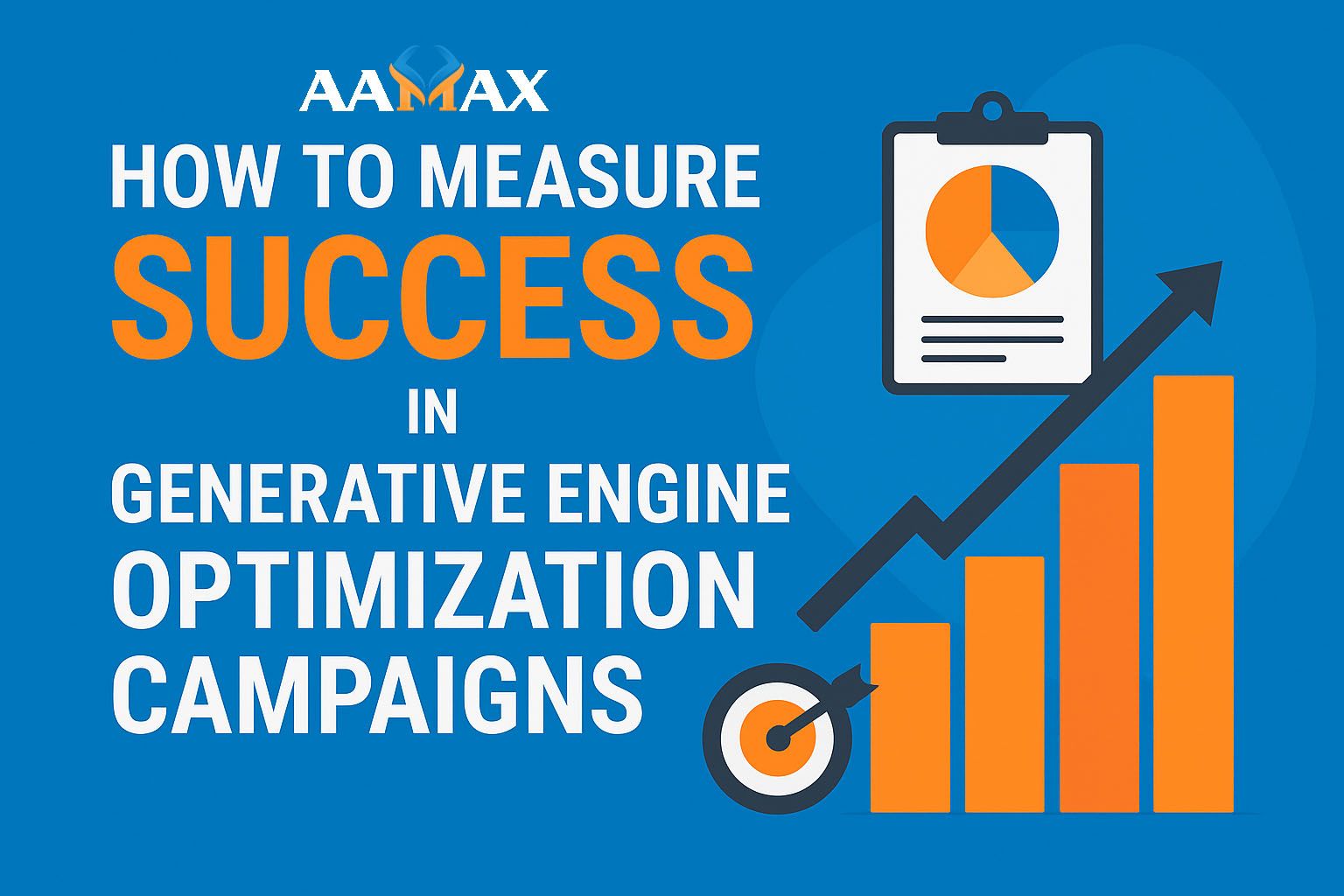
How To Measure Success in Generative Engine Optimization Campaigns
The rise of Generative Engine Optimization (GEO) has changed the landscape of digital marketing and search visibility. As generative AI-powered search engines like Google’s SGE, Bing Copilot, and ChatGPT Search evolve, brands are rethinking how they optimize for discoverability. Unlike traditional SEO, which focuses on ranking in blue links, GEO focuses on influencing AI-generated summaries, answers, and recommendations.
But while implementing GEO strategies is critical, the real question for marketers and business owners is: How do you measure success in a Generative Engine Optimization campaign?
This comprehensive guide breaks down how to evaluate performance, set benchmarks, and use actionable KPIs to track GEO success.
Understanding Generative Engine Optimization (GEO)
Before we can measure GEO success, it’s vital to understand what it entails.
Generative Engine Optimization focuses on improving your brand’s visibility and authority within AI-generated outputs. Instead of simply optimizing for ranking signals like backlinks or meta tags, GEO focuses on semantic relevance, brand authority, and trustworthiness as perceived by AI-driven engines.
AI-driven search experiences such as Google’s SGE (Search Generative Experience) or Bing Copilot use large language models (LLMs) to generate responses that summarize and interpret web content. If your brand or content is consistently referenced, summarized, or cited within these AI-generated answers, that’s a win for GEO.
The Key Difference from Traditional SEO
| Factor | Traditional SEO | Generative Engine Optimization | |---------|----------------|--------------------------------| | Goal | Rank high on SERPs | Be referenced or included in AI-generated answers | | User Experience | Click-based browsing | Conversational or summary-based engagement | | Optimization Focus | Keywords, backlinks, and on-page signals | Entity authority, trust, content depth, and semantic clarity | | Measurement | CTR, rankings, and organic sessions | Mentions, inclusion rates, engagement from AI answers |
Why Measuring GEO Success Matters
Just like SEO analytics drive strategy and investment, measuring GEO success ensures you’re not optimizing blindly. Without concrete performance indicators, it’s impossible to know whether your efforts are generating visibility or conversions in this new AI-driven ecosystem.
Effective GEO measurement helps you:
- Quantify brand visibility in generative engines.
- Understand how AI interprets and summarizes your content.
- Optimize content strategy for entity recognition and semantic relationships.
- Evaluate ROI of GEO efforts across digital touchpoints.
Key Metrics to Measure Generative Engine Optimization Success
Let’s dive into the most important metrics and tools that can help you measure GEO performance effectively.
1. Inclusion Rate in Generative Answers
This is the cornerstone metric for GEO campaigns. The inclusion rate measures how often your website, brand, or content is referenced in AI-generated search results.
How to Track:
- Perform sample searches in Google’s SGE, Bing Copilot, or ChatGPT Search.
- Note how frequently your brand or URL appears in generated summaries.
- Use tools that track AI response citations (emerging GEO analytics platforms now provide this data).
Why It Matters:
If your brand consistently appears in AI-generated summaries, it signals that generative engines recognize your site as a trustworthy authority—a crucial factor for long-term visibility.
2. Entity Authority and Recognition
Generative engines rely heavily on entity-based data. Instead of focusing on keywords, they identify entities (brands, people, places, products) and their relationships.
How to Measure:
- Use tools like Google’s Knowledge Graph API or the SEO Entity Analyzer to see if your brand is recognized as a unique entity.
- Track entity presence in structured data and third-party databases such as Wikidata or Crunchbase.
- Monitor AI mentions by prompting models like ChatGPT or Gemini with “What is [Your Brand Name]?”
Why It’s Important:
The stronger your entity authority, the more likely your brand will appear in contextual AI answers, driving consistent exposure even without direct website clicks.
3. AI-Generated Mentions and Citations
Monitoring mentions in AI-generated content (including SGE answers, summaries, and AI-curated snippets) is an essential GEO metric.
How to Track:
- Set up AI monitoring tools or scripts to detect mentions in generative outputs.
- Use conversational search tools or browser extensions that reveal the source URLs used in AI summaries.
- Track branded keyword visibility in AI contexts.
Example:
If your website is cited as a source or referenced in “People Also Ask” generative answers, it shows you’re gaining semantic trust from AI engines.
4. Brand Sentiment and AI-Generated Tone
Since AI engines summarize and interpret your content, it’s not just about being mentioned, but how you’re mentioned.
How to Measure:
- Run brand-related prompts in generative engines and analyze the tone (positive, neutral, or negative).
- Use sentiment analysis tools to evaluate AI-generated mentions.
- Regularly audit how AI models describe your products, services, or reviews.
Why It’s Crucial:
Generative AI often reshapes brand narratives based on the content it ingests. Maintaining positive AI sentiment ensures you control your brand reputation in the new search paradigm.
5. Traffic from AI-Driven Sources
Even though AI-generated answers often reduce traditional click-through rates, users still engage with links embedded in AI responses.
How to Measure:
- Use UTM parameters for AI-optimized content.
- Track referral sources labeled as “AI,” “SGE,” or “Chatbot” in your analytics tools.
- Compare engagement metrics (session duration, conversion rate) between AI referrals and traditional organic traffic.
Why It Matters:
Understanding user behavior from AI-driven channels helps you optimize content for both engagement and conversion, not just visibility.
6. Engagement Metrics and Behavioral Signals
Generative search users tend to spend more time reading summaries and less time clicking multiple links. However, when they do visit your site, they usually have stronger intent.
Metrics to Track:
- Average time on page
- Scroll depth
- Bounce rate
- Conversion actions (form fills, downloads, purchases)
Insight:
Higher engagement indicates that your content aligns with AI recommendations and resonates with the intent-driven audience emerging from generative engines.
7. Share of Generative Visibility (SGV)
Just like “share of voice” in traditional SEO, Share of Generative Visibility (SGV) measures how visible your brand is compared to competitors in generative search responses.
How to Calculate:
- Identify top generative results for your target keywords.
- Record how often your brand appears relative to competitors.
- Calculate SGV = (Your Brand Mentions / Total Mentions in Generative Responses) × 100
Example:
If you appear in 25 out of 100 generative answers for a keyword cluster, your SGV is 25%.
This metric provides a clear competitive snapshot of how dominant your GEO efforts are across AI-driven search results.
8. Conversion and Revenue Attribution from GEO
Ultimately, success is defined by results—not just visibility. Tracking conversions attributed to GEO ensures that your investment translates into measurable business outcomes.
How to Measure:
- Use custom attribution models that include generative engines as touchpoints.
- Assign AI-influenced conversions through last-click or assisted-conversion models.
- Measure ROI of AI-optimized content versus traditional SEO pages.
Why It’s Valuable:
This helps determine whether GEO contributes directly to lead generation, sales, or brand trust—beyond vanity metrics.
Tools and Platforms for GEO Analytics
Because GEO is a developing field, the toolset is still expanding. However, several platforms and methods can help you measure performance effectively.
Recommended Tools:
- Google Search Console (SGE Insights) – for tracking generative appearances.
- ChatGPT Enterprise or API logs – for monitoring how often your site is cited.
- SEO Entity Auditors – to measure entity presence and knowledge graph visibility.
- AI Citation Trackers – new third-party tools that track AI-generated mentions.
- Brand Monitoring Tools – such as Mention or Brandwatch for AI-based sentiment insights.
By combining traditional analytics with GEO-focused tracking, you create a hybrid measurement system that captures AI-driven visibility and human engagement together.
Setting Realistic GEO Benchmarks
Because GEO is still evolving, defining benchmarks is critical.
Suggested Benchmarks:
- 3–6 months: Establish brand inclusion in AI-generated summaries.
- 6–12 months: Increase entity recognition and improve brand sentiment.
- 12+ months: Achieve consistent visibility across multiple generative engines.
Keep in mind that GEO performance depends on content freshness, trustworthiness, and data quality. The more semantically rich and authoritative your site is, the higher your visibility in AI-generated outputs.
Integrating GEO Metrics with Your Broader Digital Strategy
To make the most of GEO measurement, integrate it with other digital marketing channels:
- Align GEO goals with content marketing KPIs such as engagement and conversions.
- Coordinate with SEO teams to optimize structured data and knowledge graph signals.
- Use GEO insights to improve social proof and PR efforts, since AI models draw from diverse data sources.
This integrated approach ensures that every marketing channel reinforces your AI visibility footprint.
Common Mistakes in Measuring GEO Success
Even experienced marketers can misjudge GEO performance. Avoid these pitfalls:
- Relying only on traditional SEO metrics – GEO success isn’t just about rankings.
- Ignoring entity optimization – Without entity recognition, AI engines won’t connect your brand contextually.
- Not tracking sentiment – Negative AI summaries can harm reputation.
- Skipping performance attribution – Failing to map GEO to conversions hides ROI.
- Measuring too soon – GEO campaigns often take months to influence AI models.
Patience and consistency are key. GEO requires iterative optimization and ongoing monitoring, not quick wins.
Final Thoughts: Measuring GEO Success for Long-Term Growth
Generative Engine Optimization represents the next evolution of search—a landscape where AI determines visibility, authority, and influence. Success in GEO campaigns isn’t about vanity rankings or backlinks alone; it’s about becoming the trusted source AI engines rely on when generating answers.
To measure success effectively:
- Focus on inclusion rates, entity recognition, and AI mentions.
- Track engagement and conversions from AI-driven traffic.
- Monitor brand sentiment and share of generative visibility.
By mastering these metrics, you can future-proof your brand’s digital presence in an AI-first world.
For businesses looking to strengthen their GEO, SEO, and overall web presence, consider partnering with AAMAX — a full-service digital marketing company offering Web Development, Digital Marketing, and SEO Services. Their team can help you craft a data-driven GEO strategy that not only improves visibility in generative engines but also drives measurable business growth.







